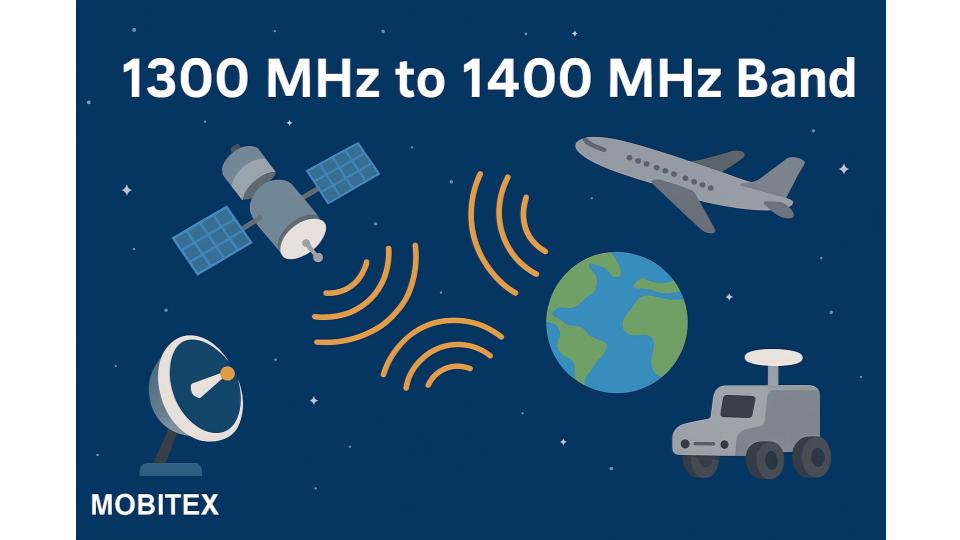The 1300–1400 MHz band is part of the upper L-band and is mainly used for radiolocation (radar), aeronautical radionavigation, and Earth-observation applications. It is a globally important frequency range for long-range radar, air-traffic control, and scientific remote sensing.
Overview
This 100 MHz-wide band plays a central role in civil and military radar operations. Its propagation characteristics – low atmospheric loss and moderate antenna size – make it ideal for long-range surveillance and tracking. It is also used by Earth-exploration satellites, particularly synthetic aperture radar (SAR) missions, which rely on this range for high-resolution imaging of the Earth’s surface.
Unlike some other L-band segments, the 1300–1400 MHz band is tightly controlled and not available for amateur or unlicensed communications. It is primarily a protected radar band, coordinated internationally under ITU regulations.

Primary Services
1. Radiolocation (Radar)
- This is the primary allocation worldwide.
- Used for air-traffic control radars, weather monitoring, and military surveillance.
- The band’s lower frequency provides long-range coverage with minimal atmospheric absorption, allowing detection of aircraft, ships, and terrain features over large distances.
2. Aeronautical Radionavigation
- Used for airborne radar systems and navigation beacons.
- Aircraft radar altimeters and navigation systems sometimes operate near this range for altitude and terrain mapping.
3. Earth-Exploration and Space Research
- Satellite-based L-band Synthetic Aperture Radar (SAR) systems operate around 1300–1375 MHz.
- These missions include soil moisture mapping, deforestation tracking, ice monitoring, and disaster assessment.
- Examples: ALOS PALSAR, NASA’s NISAR mission, and ESA’s BIOMASS satellite operate within or adjacent to this band.
4. Fixed and Mobile Services (Limited or Regional)
- Some countries allow fixed wireless links or telemetry in the upper portion of the band (typically above 1380 MHz), but only under strict coordination with radar services.
- Usage is secondary and geographically restricted.
Technical Characteristics
| Parameter | Value / Description |
|---|---|
| Frequency Range | 1300–1400 MHz |
| Wavelength | ~23 cm |
| Propagation | Excellent for long-range detection and ground penetration |
| Antenna Size | Compact – suitable for airborne and spaceborne radars |
| FSPL @ 10 km | ~112 dB |
| Quarter-wave Antenna Length | ~5.75 cm |
Regulatory Context
- Primary Allocation: Radiolocation and Earth-exploration (active).
- Secondary Allocation: Space research (active).
- Restrictions: Amateur, commercial, and unlicensed uses are not permitted in most regions.
- ITU Footnotes: Emphasize protection for Earth-observation satellites and radar systems.
In ITU Region 2 (Americas), this band is fully reserved for radiolocation and Earth-exploration satellites, with some additional provisions for aeronautical radionavigation.
Real-World Applications
- Air-traffic Control Radar (ATCRBS, Mode-S): Ground-based systems that track aircraft at long ranges.
- Weather and Airborne Radar: Used for precipitation monitoring and airborne terrain mapping.
- Defense Surveillance: Long-range, high-power radars for early warning and missile detection.
- Earth-Observation Satellites: L-band SAR systems that penetrate vegetation and soil to study environmental changes.
Why This Band Matters
The 1300–1400 MHz band is one of the few spectrum ranges that combines long-range radar capability with excellent imaging and environmental monitoring potential. It enables continuous observation of Earth systems, reliable air-traffic management, and national defense operations.
Summary
The 1300–1400 MHz band is a cornerstone of global radar and Earth-observation infrastructure. It powers long-range detection, weather monitoring, and environmental sensing from space. Protected from commercial and amateur use, this band ensures that vital surveillance and scientific missions operate without interference – making it one of the most strategically significant parts of the L-band spectrum.
